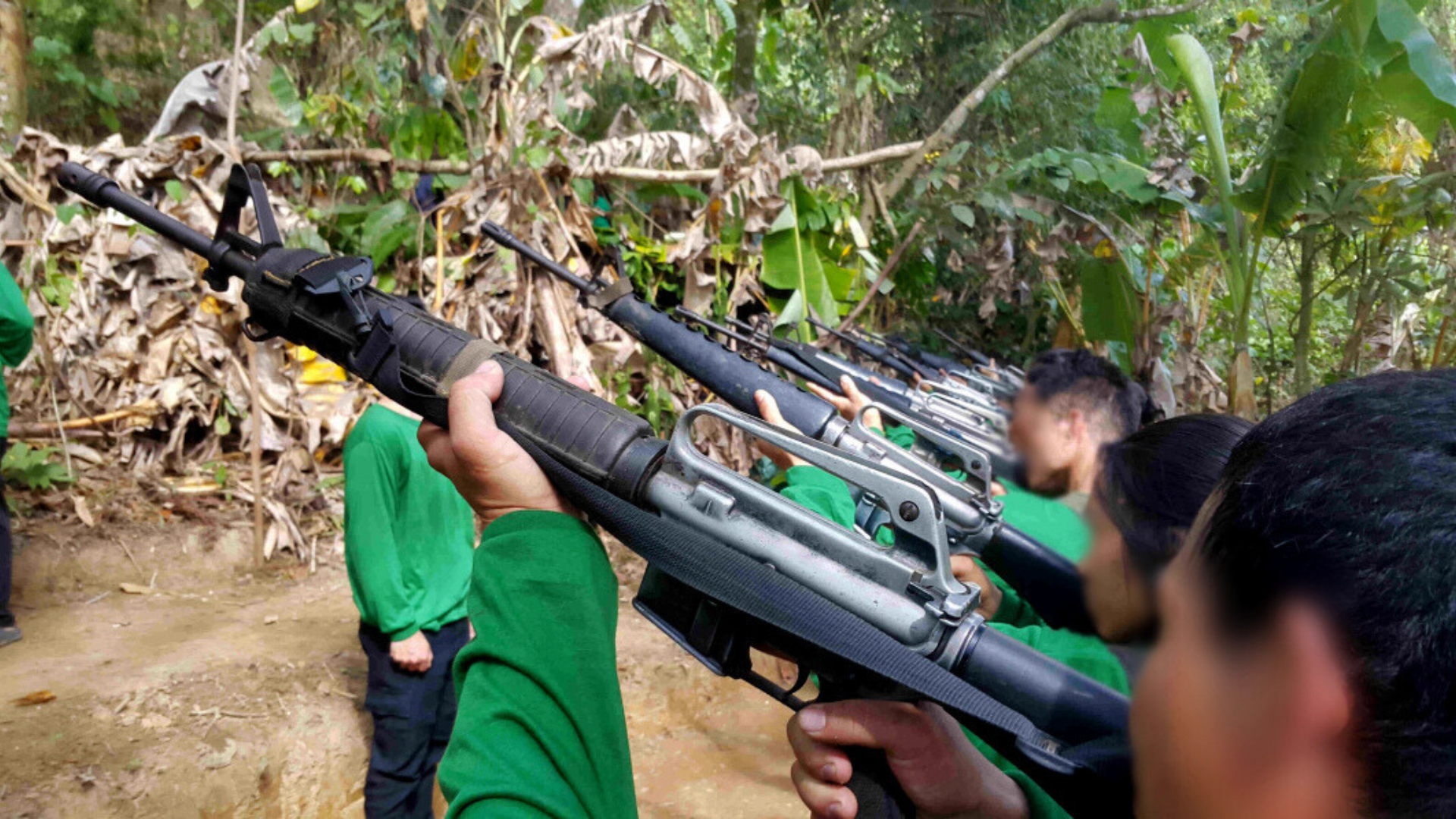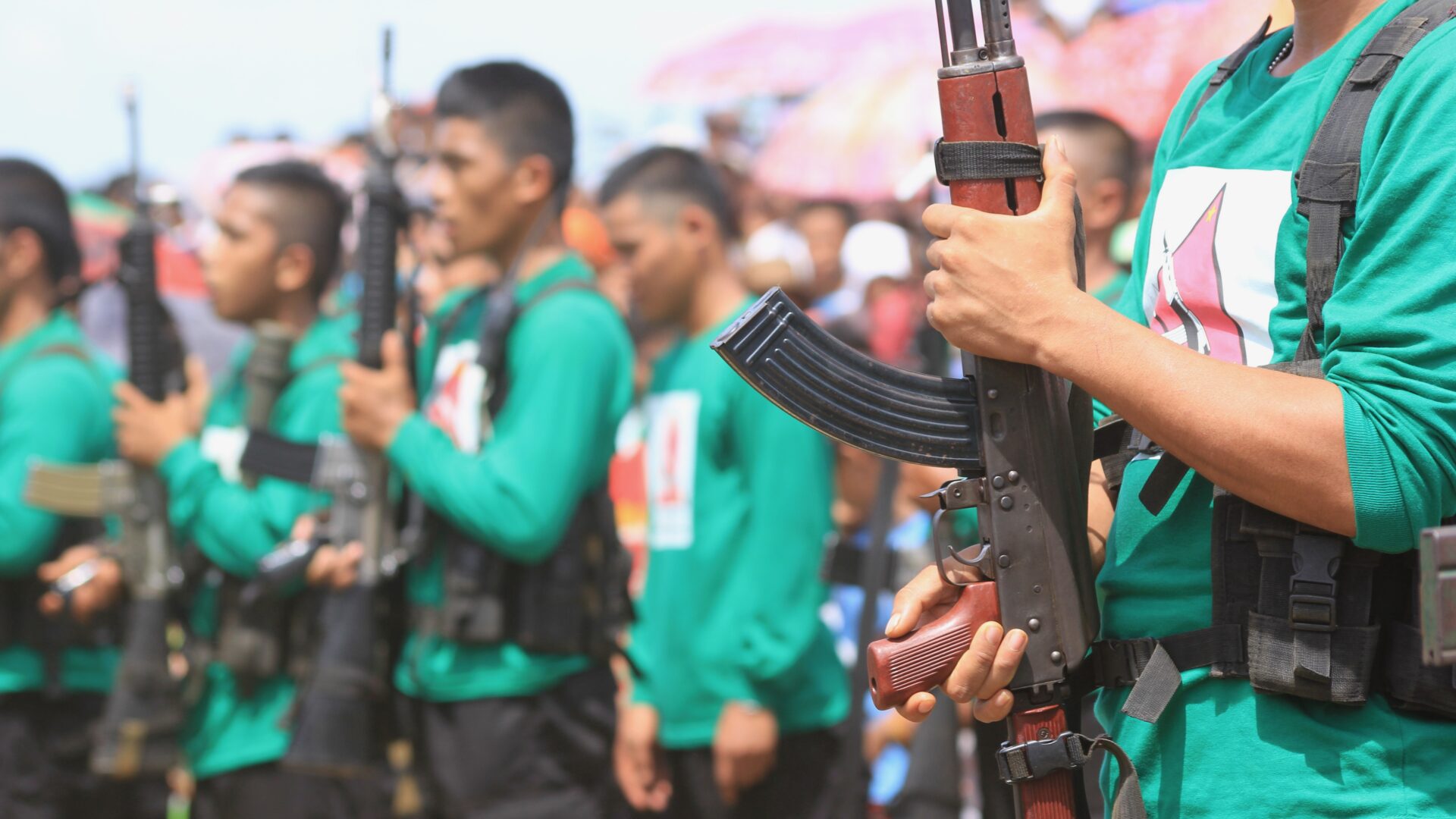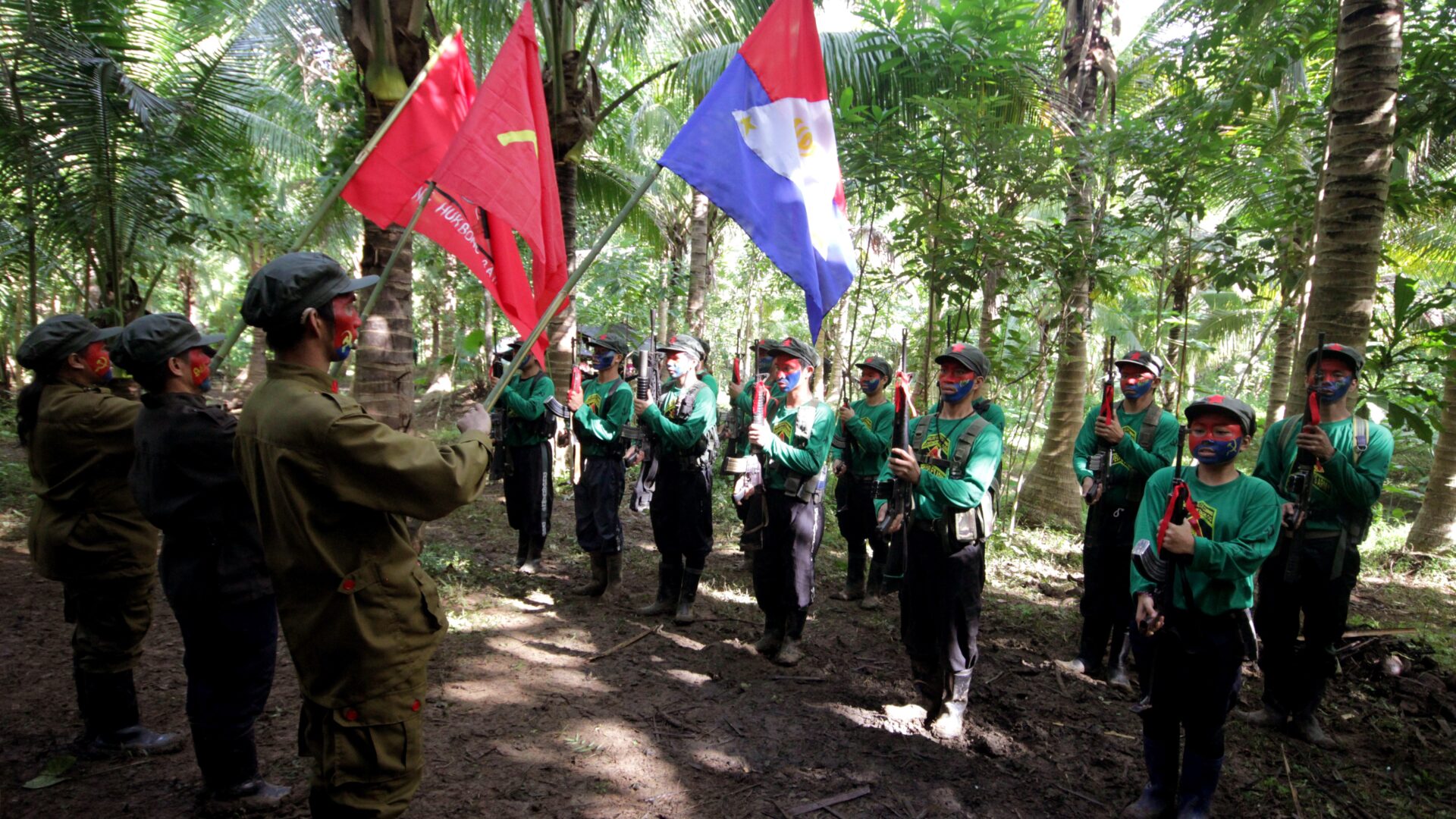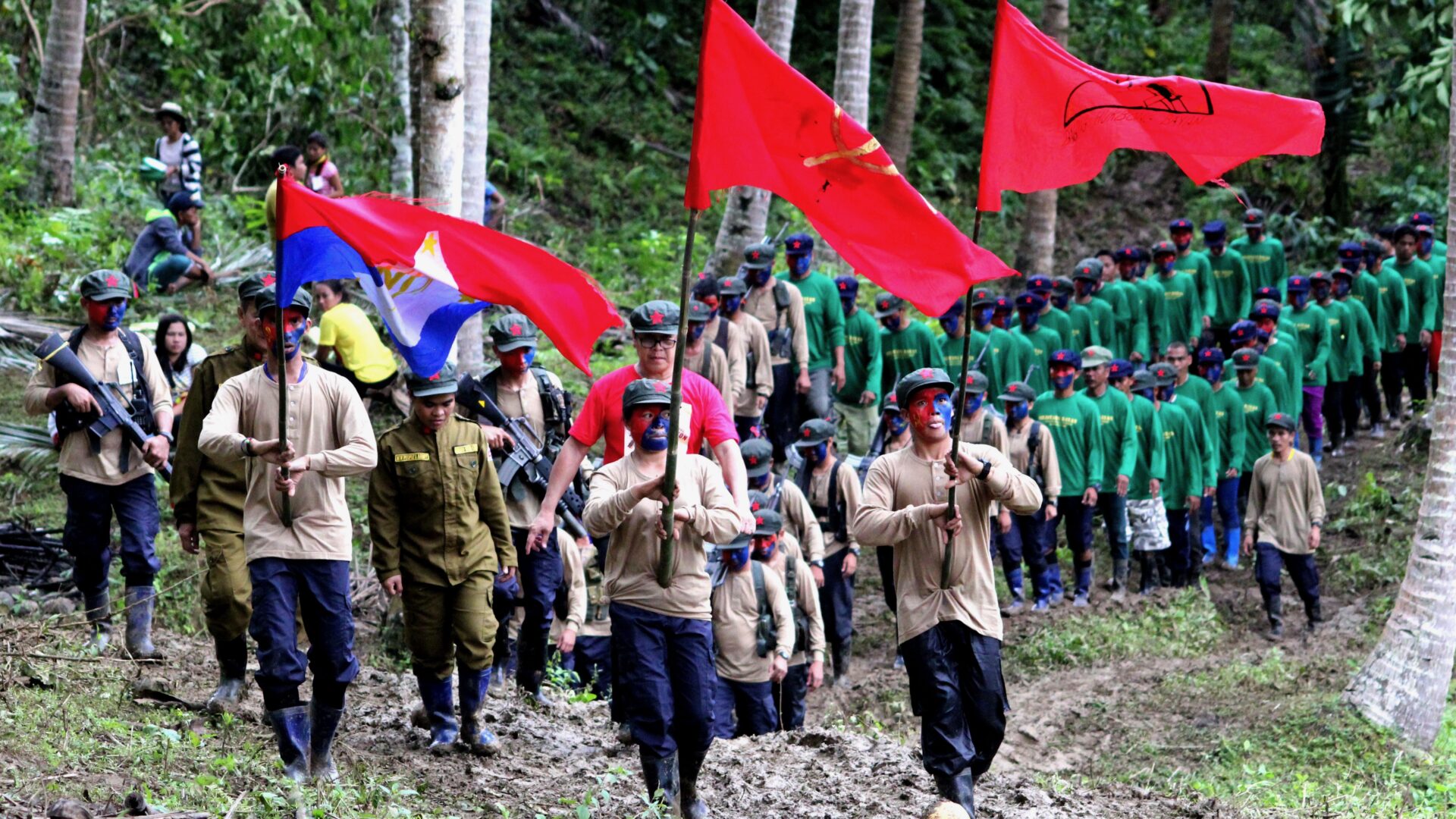Capitulation no substitute for national liberation
Dutch activist Thomas van Beersum replies to the now-infamous Jacobin Magazine article, and gives thorough review of what became of the counterrevolutionary currents in the Philippines today.
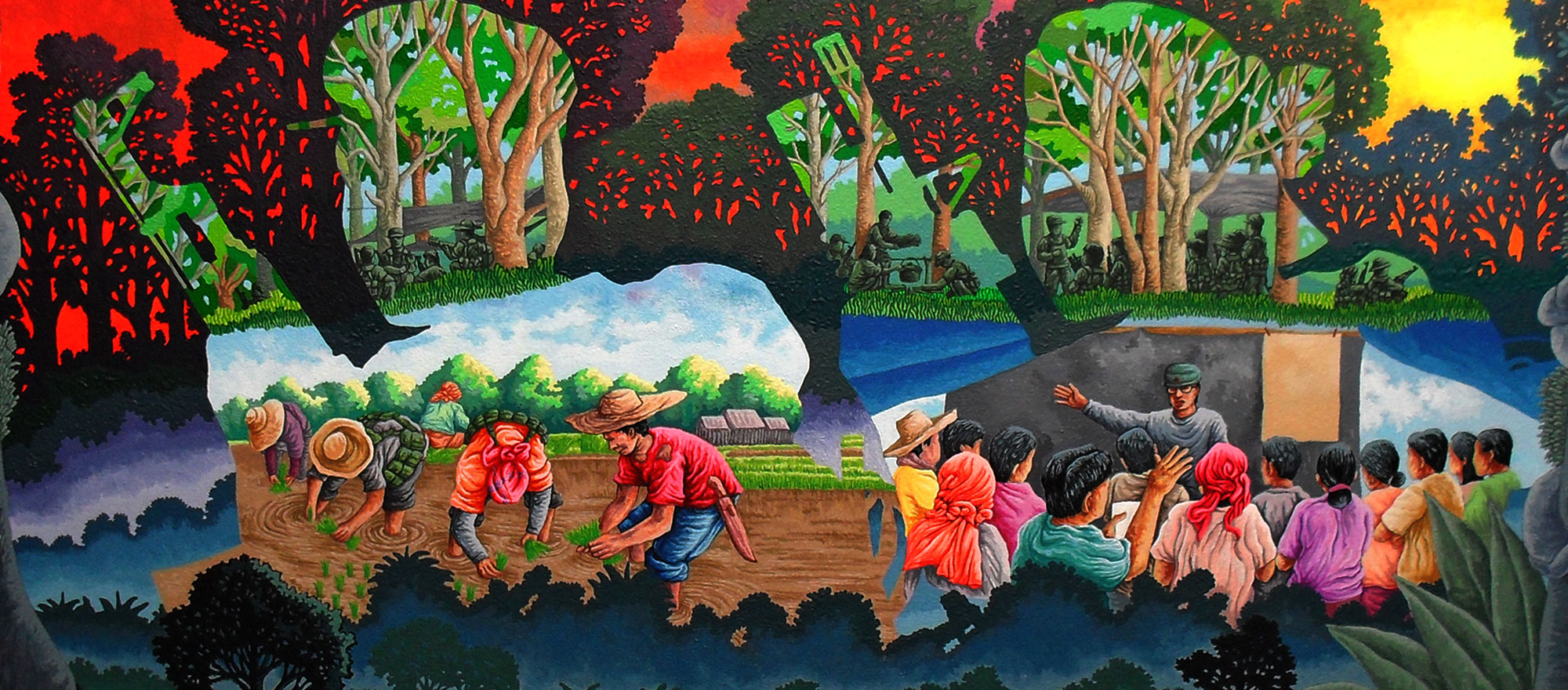
(EDITOR’S NOTE: Pinoy Weekly publishes another critique of the now-infamous Jacobin Magazine online article on the Philippine revolutionary movement–this time written by Dutch activist Thomas van Beersum. Beersum, of course, is known to some Filipinos as the “foreigner” who heckled a policeman during a protest action against the State of the Nation Address in Manila some years ago. For his involvement in solidarity work and protest actions in the Philippines, Van Beersum was held overnight at the airport when he was to depart for The Netherlands, and subsequently deported and blacklisted by Philippine immigration officials. Despite the experience, he continues to be actively involved in the Philippine solidarity movement in The Netherlands.)
![]() Who does this Alex de Jong think he is? Either he has not studied the Philippine revolution, or he has deliberately distorted facts to fit his own warped sectarian view. In his article, published by Jacobin Magazine, he tries to paint a picture of the Communist Party of the Philippines (CPP) as “orthodox Stalinist monsters marching towards irrelevance”. He echoes the same malicious allegations which the reactionary Philippine state has been spouting for the last 46 years.
Who does this Alex de Jong think he is? Either he has not studied the Philippine revolution, or he has deliberately distorted facts to fit his own warped sectarian view. In his article, published by Jacobin Magazine, he tries to paint a picture of the Communist Party of the Philippines (CPP) as “orthodox Stalinist monsters marching towards irrelevance”. He echoes the same malicious allegations which the reactionary Philippine state has been spouting for the last 46 years.
In reality, the Philippine revolutionary forces are strong and vibrant. Having outgrown without their former “left” and right opportunist elements, they continue to make headway in advancing towards the seizure of state power. This is a result of the Second Great Rectification Movement that criticized and repudiated the handful of opportunist elements that had degenerated under various bourgeois influences, including neoliberalism, revisionism and Trotskyism.
The CPP continues to build organs of political power among millions of workers and peasants in thousands of Philippine villages, in accordance with the strategic line of Protracted People’s War. The general line of People’s Democratic Revolution with a socialist perspective has generated a strong party of the revolutionary proletariat with 200,000 members, the New People’s Army with 10,000 full-time red fighters, tens of thousands of people’s militia, hundreds of thousands of men and women in self-defense units, and millions of people in the 18 organizations of the National Democratic Front of the Philippines.
Yet de Jong has the audacity to proclaim “the end” of a rich and dynamic national liberation movement shaking a base of imperialism in Southeast Asia, despite the fact that his own organization pales in comparison to the organizational strength and capacity of the organizers of the Philippine national democratic movement active in his own country, the Netherlands.
De Jong tries to make it appear as if the only reasons the CPP play a leading role in the Philippine struggle are simply because of the worsening conditions in the country and because of the armed struggle’s “romantic” appeal. This is an insult to the proletarian intellect of the millions of supporters of the national democratic revolution in the Philippines, who are rooted among the most oppressed and exploited sections of the people.
This is a ridiculous paternalistic presumption from someone whose “left” chauvinist group believes that the “international communist revolution” has to be politically led by and oriented towards the Fourth International, the “strategic censor” based in Paris, France.
As a way to “prove” that the CPP is “being worn down by the passage of history”, de Jong exaggerates the size and significance of the CPP-splinters even as he decries their self-destructive status and course. These grouplets, whose legitimacy in the eyes of the international progressive community is becoming smaller day by day, are running out of their “revolutionary prestige” and hence need to use people like de Jong to make unfounded boisterous claims about them.
The question of primary importance for the revolutionary movement in the Philippines is still: Who are our enemies, and who are our friends? And let’s be clear, the “broad” and “ideologically heterogeneous” left composed of CPP-rejects are no alternative for the CPP, and they should in no way be conceived of as ‘friends of the people’.
Sneaky tricks
Many of the claims de Jong makes about the CPP are contradictory and reveal his shallow understanding of facts on the ground.
The national democratic (ND) line is, according to him, “strangely out of time”, but he also acknowledges that the national democrats remain by far the strongest current on the Philippine left.
De Jong accuses the CPP of branding everyone who does not follow a Maoist line as an “enemy of the revolution”, but at the same time he also accuses the CPP of violating revolutionary principles by engaging in united fronts and alliances, and decries the fact that the mass movement’s membership is based on a national democratic line rather than a strict ideologically socialist or communist one.
Furthermore, he also admits that the CPP ideology remains the dominant tendency and that alternative interpretations of socialism are almost nowhere to be found. If that is the case, how can he also claim that few people in the (ND) mass movement discuss socialism or Marxism?
Even when he slanders the CPP, de Jong feels the need to also praise their undeniable achievements. He even has to admit that the communists and NDs by far are the most relevant, that they are able to reach out to and organize millions of Filipinos around their political line, that they retain strong civilian support, that their means and infrastructure overshadow those of the other left groups, and that their ideology remains very influential even among the mainstream.
To show his thorough disdain for the revolutionary forces in the Philippines, his article could actually put them in danger. De Jong shows no respect for the distinction between the legal national democratic mass organizations and the different underground revolutionary groups. Due to the anti-communist political climate pushed by the reactionary state, when someone is branded as a communist it creates the ground for them to get abducted and/or killed. De Jong “outs” several organizations as being fronts for the CPP, and he even goes as far as naming a left-wing personality who is out in the open as being the rumored new chief of the Party. This “red-baiting” technique is frequently made use of by the Philippine military and its “left” lackeys.

Rectification
De Jong’s claim that the CPP- and ND-aligned left are equal in size to the other left groups put together is laughable and unsupported. But before countering that claim, we should examine how the split between the CPP and the grouplets originated. To do this, we must look back at the Second Great Rectification Movement which launched in 1992.
The Second Great Rectification Movement was a huge ideological and educational initiative inside the CPP that criticized and repudiated the subjectivist line that the Philippines was no longer semi-colonial and semi-feudal and that the line of Protracted People’s War was wrong, as well as the “left” opportunism and right opportunist lines which arose from such subjectivism.
The left opportunist line had variations. The CPP leadership of Rodolfo Salas put forward the “strategic counter-offensive” line of leaping over from the strategic defensive to strategic counter-offensive without developing the strategic defensive and strategic stalemate stages fully. (For those less familiar with military-political strategy, I suggest reading On Protracted War by Mao Zedong.)
But the main target of the Second Great Rectification Movement was the worst case of self-destructive left opportunism, which at the time was prevalent especially in Mindanao. Several high-level cadres of the party there tried to improve and adopt a line that tried to deviate from the strategic line of Protracted People’s War. They wanted to ‘finish the fight quickly’ using adventurist methods.
Their idea was to use urban insurrection by the spontaneous masses as the leading, politico-military force, while depreciating the people’s army as a mere military force to be reorganized into concentrated companies. This would have been a detrimental strategy for the seizure of political power in a country like the Philippines. They neglected mass work and isolated themselves from the masses. Because of this erroneous line, the Party, the peoples’ army and the revolutionary machinery became particularly vulnerable to tactical attacks by enemy forces.
The militarist line was easily overcome by the enemy. But instead of criticizing themselves, they blamed their failures on “deep penetrating agents” or “DPAs”. The wrong line ignited a hysteria in the organization that they would call “Kampanyang Ahos”, a campaign that resulted in the torture and killing of hundreds of party members, activists and allies without due process.
Kampanyang Ahos was not a “bloody purge”; it was a gigantic anti-communist and anti-people crime, not just a tactical error and not even merely an ideological-political-organizational matter internal to the Party. At the time of the campaign, the founding chairperson of the CPP, Jose Maria Sison (“Joma”), was in maximum security prison and held no official position in the Party. Still, he was one of the first people who called for an investigation into the “Ahos” campaign. In Joma’s book, The Philippine Revolution: The Leader’s View, he already exposed and condemned the crime back in 1988.
The Second Great Rectification Movement caused a split within the national democratic movement. Those who reaffirmed the Maoist line became known as the Reaffirmists (RAs), and those following a different line who were either expelled or bolted out of the party themselves were known as the Rejectionists (RJs).
(For those interested in the theoretical contributions, the significance and necessity of the rectification movement, I advise everyone to at least read its basic documents: Reaffirm Our Basic Principles and Rectify Errors, General Review of Important Events and Decisions from 1980 to 1991, and Stand for Socialism Against Modern Revisionism.)
The grouplets
Let’s take a look at this “heterogeneous left” that de Jong is so supportive of. What has really become of these anti-CPP grouplets? Let’s go through the most relevant ones (relevant for this article, that is) one by one.
Akbayan
Each president in the Philippines has effectively utilized (or perhaps, neutralized) “its own” left. These “left” groups portray themselves through their “critical” aesthetic on the outside, but in essence they serve only as an extension of the power of the reactionary ruling classes.
The most successful at gaining high positions in the reactionary government usually evanesce as retired successful crooks after their presidential patrons step down from power. Examples are the Popular Democrats (PopDems) Horacio Morales Jr. as secretary of the ironically named Department of Agrarian Reform and Edicio De La Torre as Tesda director under the Estrada regime; Mike Defensor of Sanlakas who became the close political advisor to Gloria Macapagal-Arroyo, and the social-democratic Akbayan cronies who became the backbone of current president Aquino’s own criminal administration.
De Jong’s own organization maintains close links with Akbayan up to this day; perhaps this is why he downplays Aquino’s human rights violations (which according to him apparently only continue under a “decreased” level during his presidency).
Akbayan or “Akbayan Citizens’ Action Party” was an active participant in international social-democratic alliances such as the “Socialist International” and the “Progressive Alliance”. These international affiliations were at the time centered around the imperialist politics of the “left-wing” war parties such as the PvdA in the Netherlands and the Labour Party in the UK.
Many Akbayan leaders have enjoyed opportunistic and anti-communist political careers. Joel Rocamora, Walden Bello, Etta Rosales and Ricardo Reyes were all leaders of Siglaya, a coalition of former national democrats linked to the Fourth International. Part of Siglaya joined with the social-democrats headed by Ronald Llamas (who is now the presidential political affairs advisor of Aquino) to form Akbayan, the “progressive” anti-CPP attack dog of the Aquino regime. Through Akbayan, those who previously called themselves liberal communists only to become Trotskyites have been able to get high positions in Aquino’s cabinet.
Etta Rosales, former Akbayan president, was the chief of the Human Rights Commission under Aquino until she retired last May. Aside from being active in other schemes, she engaged in whitewashing the human rights violations by reactionary military and police officers. Previous to that, she collaborated with US lawyer Robert Swift in removing thousands of human rights claimants from the list of those who initiated and won the human rights case against Marcos in the US.
Joel Rocamora, former Akbayan president and ideologue, being so against poverty, has been enriching himself further as head of the National Anti-Poverty Commission under Aquino. When Rocamora was still a co-director of the Transnational Institute (TNI), he submitted falsified reports on progressive ND-allied groups to funding agencies in Europe to expose the “Stalinist CPP fronts” the agencies had been supporting.
Ricardo Reyes, who was one of the leaders of Akbayan before he had a falling out with red-baiter Walden Bello, ordered the so-called Mindanao Caretaker Committee to carry out the Kampanyang Ahos witch-hunt, resulting in the arrest of 1500 party members and allies and in the torture and execution of more than 300 party members and allies.
Former Akbayan leader Nathan Quimpo also actively led and participated in the torture and murder acts of Kampanyang Ahos. To distract from this grievous crime, Ricardo Reyes and Nathan Quimpo became prominent in exaggerating and denouncing the Salas central leadership of the CPP for their boycott policy in the rigged 1986 snap presidential elections. When he was in The Netherlands as a political refugee, Quimpo was one of the witnesses in the case against Joma, and made a sworn statement for the Dutch state against the latter.
The right opportunist line in the CPP already arose (almost at the same time as the left opportunist line) in 1981 and became fully articulated in 1982. Its basic line was to take out the working class leadership in the united front and in effect yield leadership to the liberal bourgeoisie supposedly in order to attract more people.
The right opportunists were small and weak before the fall of Marcos, but after his fall, the so-called Popular Democrats arose to promote the line of capitulation and seeking jobs in the reactionary government. Their line was reinforced by former left opportunists like Reyes and Quimpo who had swung to the right. It was further reinforced by real DPAs like Joel Rocamora who engaged in wrecking operations in conjunction with Trotskyites from the Paris-based Fourth International.
Even when these politicians ascended to power with Aquino, you saw them splitting over attempts to bolster their own individual power. Akbayan has been splitting again with Reyes and then with Bello, who recently gave up the Philippine House of Representatives membership in congress as Akbayan, criticizing its collaboration with Aquino… after almost 5 years of his own blatant collaboration. Something about rats abandoning a sinking ship.
RPM-P/RPA-ABB
Sanlakas was a party-list group (an electoral formation in the Philippines) set up by Filemon “Popoy” Lagman in 1993. It was based on an ultra-left commandist, workerist line (inspired by Ernest Mandel) that gave no decisive value to the worker-peasant alliance and was based on the pernicious assumption that waging revolution is simply a matter of a workers’ uprising in the cities.
Although Lagman (who instigated the “June Breakthrough” and “Operation Missing Link” paranoia campaigns in Southern Tagalog) had his own rascality when it came to killing people without evidence, his insurrectionist opportunism should be seen as distinct from the opportunism in Mindanao.
The death squad group centered around Arturo Tabara (who led the biggest breakaway with arms from the CPP in Negros) eventually became part of Lagman’s group. But after some time this alliance went down, they became enemies, and Tabara became part of the launching of the Revolutionary Workers Party-Philippines (RPM-P).
Lagman also had a breakup with Nilo Dela Cruz of the armed Alex Boncayao Brigade (ABB) over the bribe money from the Amari Real Estate Company in 1998-99. The Lagman-ABB group was bribed to push the eviction of the poor inhabitants of Freedom Island in Manila to make way for a casino. 80 million pesos was left in the bank. Lagman and Dela Cruz fought over the money, eventually the son-in-law of Dela Cruz (who was under the command of Lagman) was able to get the money, and in the end Lagman had to pay with his life.
One year after Tabara leading his RPA (Revolutionary Proletarian Army) into the RPM-P, the metro Manila-based ABB led by Nilo Dela Cruz joined this new party. The ABB was the name of the Manila-Rizal Armed City Partisans under the CPP and NPA during the Martial Law years until early 1990s. It was named after trade union leader Alex Boncayao, after he was martyred by the fascists during martial law. After the Popoy Lagman clique usurped command over it and used it for criminal activities, it was condemned by the CPP and even by the Boncayao family in 1992-1993.
The RPM-P/RPA-ABB became active in killing legal personalities of the left movement, such as Bayan Muna leader Romeo Sanchez, and the group has openly admitted to having coordinated with the Philippine Army’s 61st Infantry Battallion in attacking an NPA camp in Negros. It has also been implicated in the killing of Romeo Capalla, a civilian and brother of Archbishop Fernando Capalla.
The RPM-P/RPA-ABB has received millions of pesos from the Philippine government, due to its “peace” deal. Progressive human rights group Karapatan has covered the extent of the human rights abuses of the RPM-P (harassment, murder, arson, rape).
In Negros Occidental, the RPA became the hacienda guards of reactionary big landlord Eduardo Cojuangco and received payments as an anti-NPA and anti-CPP paramilitary adjunct force of the reactionary armed forces under the Estrada, Arroyo and Aquino regimes.
Arturo Tabara was even one of the special guests of Philippine National Police Director-General Hermogenes Ebdane at the 12th founding anniversary of the National Capital Regional Police Office. Another special guest there was Romulo Kintanar, another CPP-reject and active “Ahos” participant, who served as a “resource person” of the Department of National Defense and the Armed Forces of the Philippines. Kintanar was also the designated project officer in an assassination plot (in collaboration with the Estrada government) against Joma in The Netherlands in 2000.
When ABB tried to expand and organize its own units in the cities of Negros and Panay Islands, it caused resentment from RPA over turf and loot from robbery and extortion. The RPA split with ABB and RPA itself split into different factions. The Tabara-Paduano faction of the RPM-P has been effectively disarmed in 2013 due to a peace deal with the government and is now the Kapatiran para sa Progresong Panlipunan (Brotherhood for Social Progress – KPP). Paduano represents the party-list “Abang Linkod” in the reactionary Congress.
The ABB is now a handful of elements based in Muntinglupa, Rizal, engaged in criminal activities (such as killing for hire) and espionage work for the reactionary armed forces. It practically does not exist anymore. The size of the gang fluctuates between 10 and 20. Their value as intelligence assets has dwindled. The ABB is now headed by a son of Nilo Dela Cruz (who had a split with his father over money matters), who seems to be more aggressive than the father in conducting criminal activities and attacking the NPA.
RPM-M/RPA
Ike de los Reyes was with the RPA but in 2002 formally split with them over differences on the RPM-P’s peace pact with the government and other organizational and ideological matters. His new party which was based in central Mindanao became known as the Revolutionary Workers Party of Mindanao (RPM-M). The RPM-M renamed its armed group the Revolutionary Peoples’ Army, to distinguish it from the RPM-P’s Revolutionary Proletarian Army.
At the beginning, what became the RPM-M was able to usurp command over one of the platoon remnants of the NPA in Cotabato, but this platoon has now disintegrated. For some time, they were together with Gov. Mujiv Hataman of the Autonomous Region in Muslim Mindanao who is now identified with Aquino. The RPM-M has been pretending to have an active army to negotiate with the reactionary government in order to get payments from them as an anti-NPA organization. It signed a formal ceasefire with the government in 2005, and shifted its focus to doing ‘peace and development work’. Its support base is marginal.
The RPM-M is a regular and active member of the Fourth International since 2003. The inactive website of the RPM-M is hosted by the Dutch ‘Grenzeloos’ (Borderless), de Jong’s group.
PMP
Lagman had a break over strategy with Sanlakas and its yellow workers’ union BMP, and initiated the Filipino Workers’ Party (PMP) in 1999. This was done together with several other small remnants from the CPP. In 2002, several factions merged with the PMP, such as the Democratic Proletarian Party (PPD) of Manjette Lopez (who took over the leadership of the PMP after Lagman’s death) and the Socialist Party of the Philippines (SPP) of Sonny Melencio. After some time this party practically disintegrated because the factions could not come to agreement on many issues, and while remaining under the PMP banner for some time, the groups used their respective names in issuing statements and have kept their respective alignments with international Trotskyite formations.
MLPP-RHB
The few personalities identified with the Marxist Leninist Party of the Philippines (MLPP) supported the rectification movement at first, but questioned it later. This group was founded in 1998. The MLPP formed the Revolutionary People’s Army (Rebolusyonaryong Hukbo ng Bayan, RHB), a tiny armed extortionist group with only a handful of members operating in small parts of Bataan and Zambales in Central Luzon.
PLM
In 1998, Lagman’s “theoretician” Sonny Melencio started the Socialist League which later became the Socialist Party of Labor. In 2005 a coalition of CPP-splinters called Laban ng Masa (Struggle of the Masses) was founded and Melencio became its chief spokesperson, but due to big ideological differences between the different RJ groups it went down again. Melencio was also reportedly taking many unilateral initiatives not backed by the other organizations.
In 2009, Melencio started the Partido Lakas ng Masa (Party of the Laboring Masses, PLM), the political party still linked to Sanlakas Party-list. Sanlakas dwindled and the PLM has not done any better in electoral politics. This group is linked to the Australian Trotskyite formation “Democratic Socialist Perspective” and is able to hold a rally of 100 to 200 every now and then in Manila.
Conclusion
All those splinters or grouplets that persisted in committing “left” and right opportunist errors have only splintered further and become nil or close to nil. There are many individuals and groups, but none of them seem to have a mass base (except for the Akbayan cronies who enjoy a sizeable petty-bourgeois following due to their blatant puppetry).
These groups have become either the backbone and whitewashers of the reactionary state, criminal syndicates and bodyguards for the big landlords, or small fragmented groups whose main focus still is to echo the black propaganda of the police and military elements against the communist movement.
If the Rejectionists had their way, for sure it would’ve been the end of the CPP.
Not the war, but left opportunism is over
After the Second Great Rectification Movement, the CPP, the protracted people’s war, and all legal patriotic and progressive forces have been rejuvenated, have accumulated strength and are again advancing towards strategic stalement against the US-led reactionary state.
So why does Alex de Jong insist that the war is over? There is not a single piece of evidence in his article which proves this. The main thrust of the article is ill-wished and unsupported. De Jong thinks that he and some fragmented groups are acting in a different way but in fact they are doing the work of the ruling system.
If the war is over, then who are the victors? Why is he saying this and what are the political implications? To say that the war is over, isn’t that endorsing the winners and praising the pseudo-left who have for a long time already exposed themselves as servants of the ruling classes?
Our solidarity should lie with our comrades from the Philippines and India, who at this point pioneer the World Socialist Revolution. Not with the eclectic “left-wing” lackeys of comprador reactionaries and its “progressive” armchair supporters in the West.
Long live the revolution in the Philippines!

